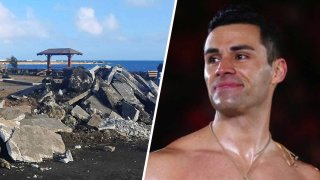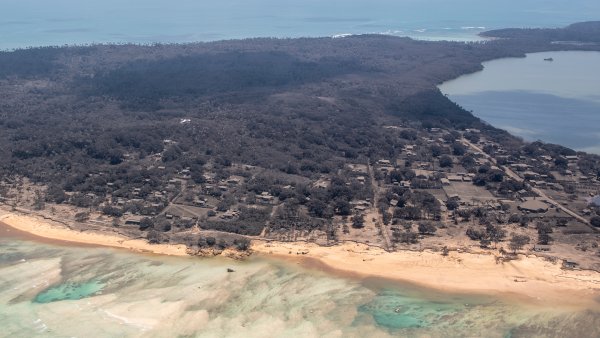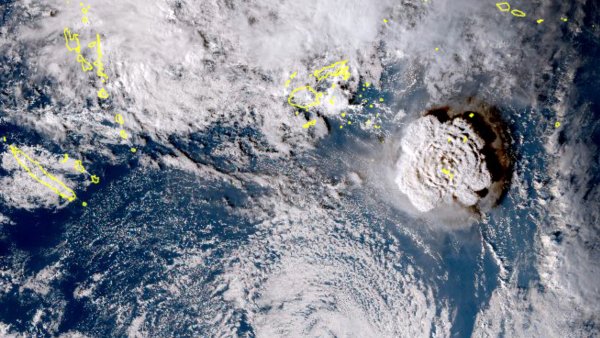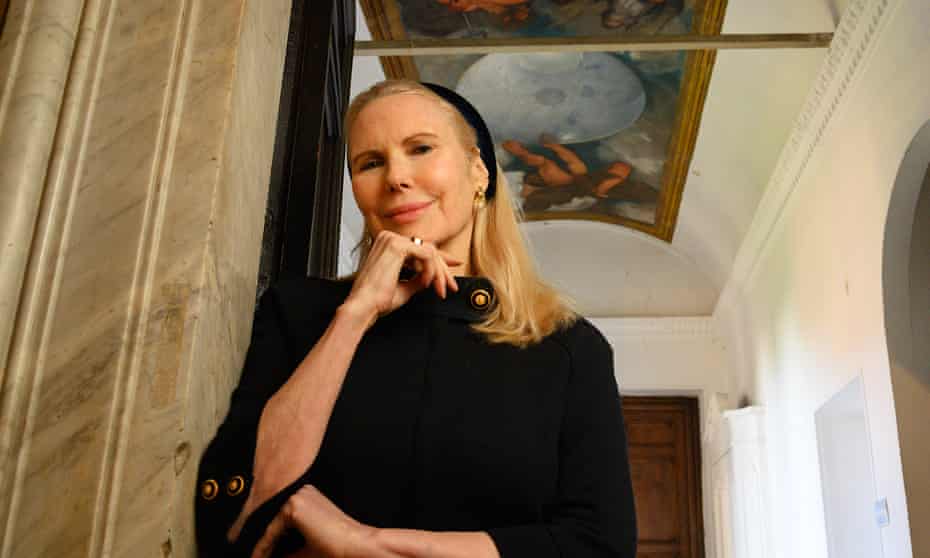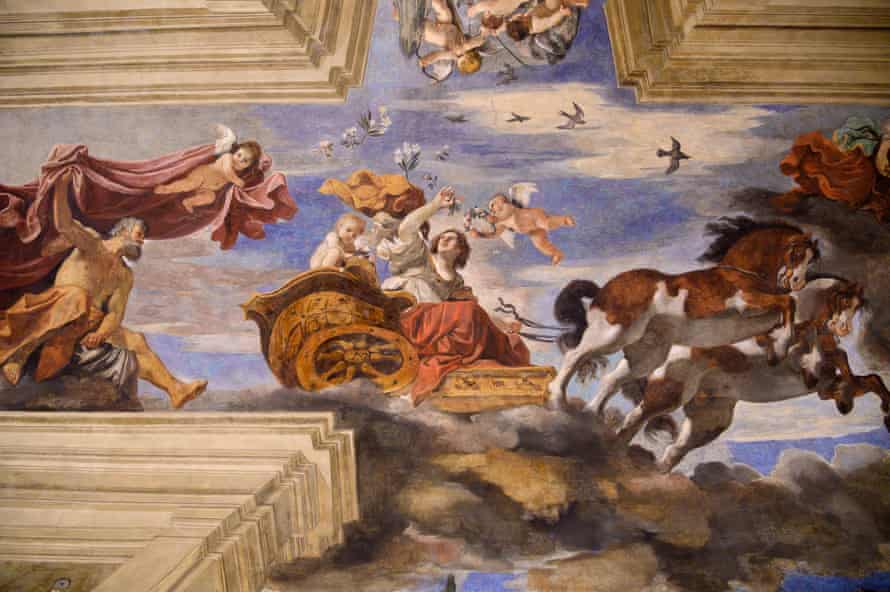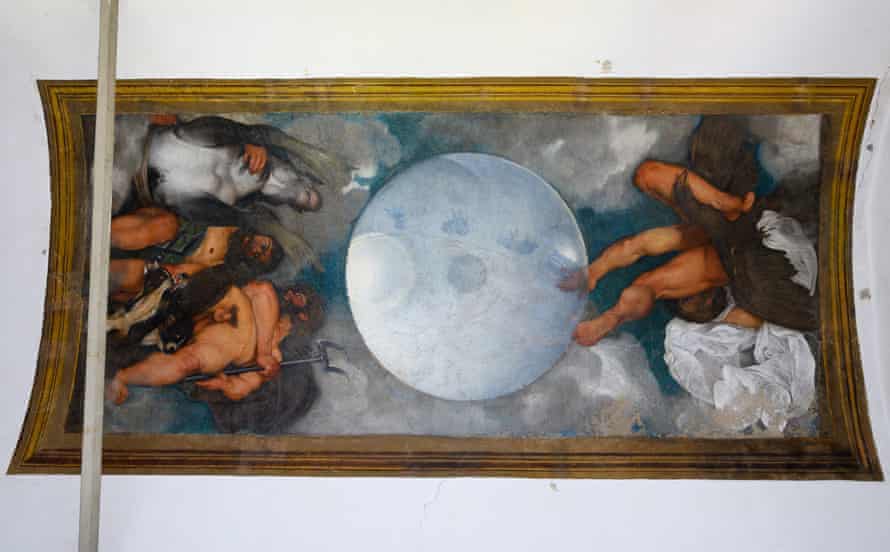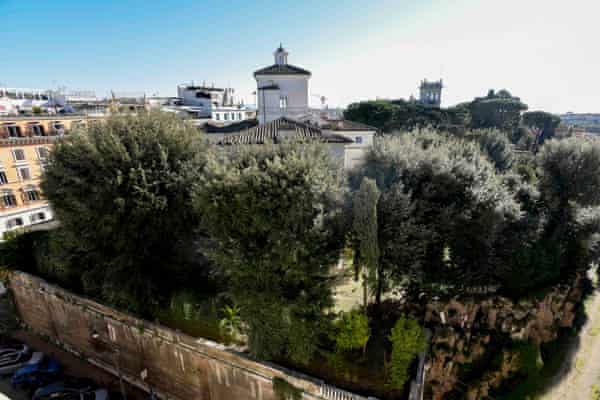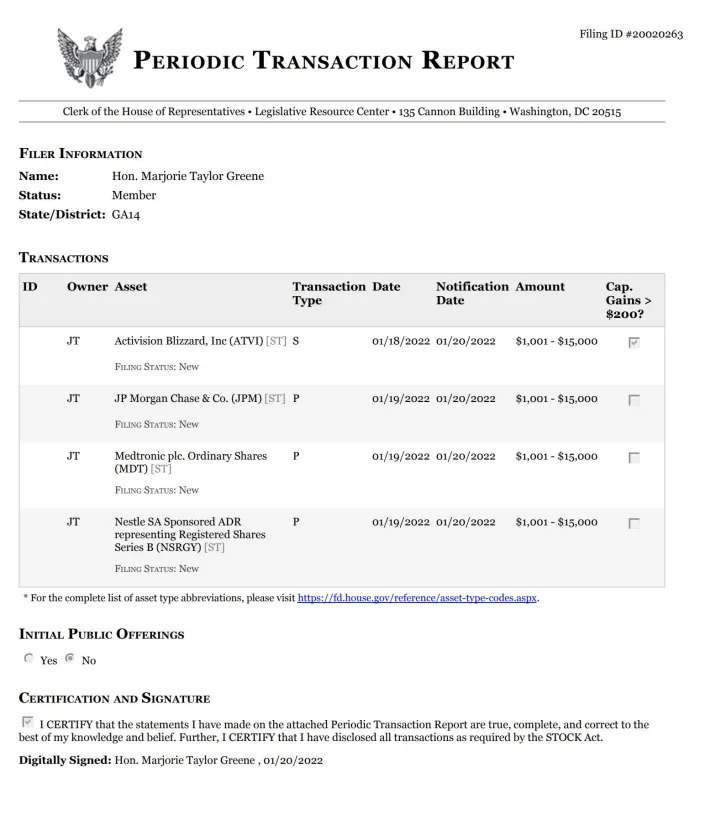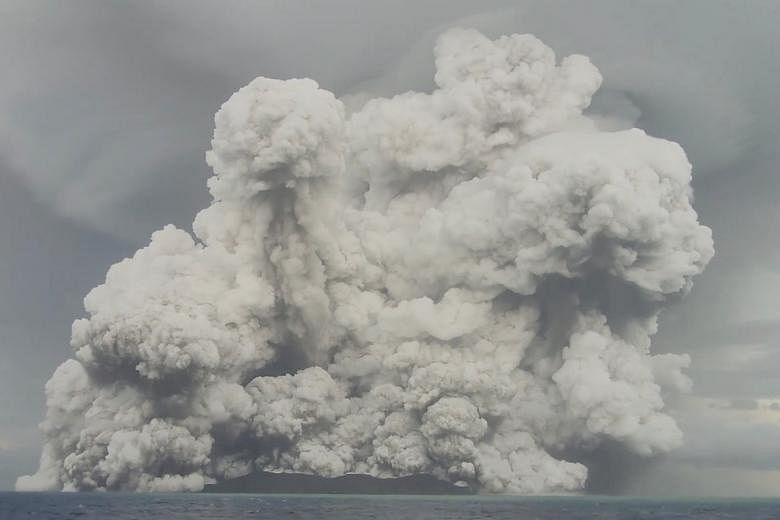
Smoke and ash billowing from the eruption of the Hunga Tonga-Hunga Ha'apai volcano on Jan 14, 2022. PHOTO: REUTERS/TONGA GEOLOGICAL SERVICES
SYDNEY (REUTERS) - Mr Branko Sugar and his son were spearfishing on an outer reef in Tonga last Saturday (Jan 15).
The air smelt of sulphur, as it had done for weeks, from the nearby active volcano, but he noticed the ash cloud from the crater was much higher.
As the 61-year-old stowed away his spearfishing gear, the first of four loud volcanic explosions rocked the tranquil South Pacific, sending a giant wave towards his boat.
"We stopped the boat and just looked. Then we saw the wave coming towards us. The biggest wave I've ever seen," Mr Sugar told Reuters via telephone from Tonga on Friday where communications are still only being restored.
Mr Sugar turned his boat, a 400-horsepower 27-foot (8m) World Cat catamaran, and accelerated towards deep water near Eueiki Island.
"That's what saved us, the power of the boat," he said. "I shouldn't be alive."
As he raced for safety, Mr Sugar telephoned his home on Tonga's main island Tongatapu to warn of the approaching tsunami, but nobody answered.
"The wave came past us and hit the main island, and then we knew we'd managed to get away. But then the rocks started raining. It was raining stones," he recalled.
In minutes, the Pacific blue sky turned to total darkness, ash enveloped everything and a storm seemed to whip up, lashing the boat with wind and waves.
A 12-mile (19km) trip home took three hours in the darkness before they reached the harbour.
"There were wrecked boats everywhere. Upside-down boats, sunken boats. We didn't know where to go," Mr Sugar said.
"And when we finally stopped, then we couldn't find our cars - they'd all been swept away. It was one thing after another. When we finally found them, I couldn't drive, I was blind from rocks pounding my eyes for hours driving the boat."
The Hunga Tonga-Hunga Ha'apai volcano eruption triggered tsunami that destroyed villages, resorts and many buildings and knocked out communications for the nation of about 105,000 people. It also sent shockwaves and tsunami across the Pacific.
Three people have been reported killed, say Tongan authorities.
Nasa's Goddard Space Flight Centre has said the force of the eruption was estimated to be the equivalent of five to 10 megatons of TNT, or more than 500 times that of the nuclear bomb the United States dropped on the Japanese city of Hiroshima at the end of World War II.
SYDNEY (REUTERS) - Mr Branko Sugar and his son were spearfishing on an outer reef in Tonga last Saturday (Jan 15).
The air smelt of sulphur, as it had done for weeks, from the nearby active volcano, but he noticed the ash cloud from the crater was much higher.
As the 61-year-old stowed away his spearfishing gear, the first of four loud volcanic explosions rocked the tranquil South Pacific, sending a giant wave towards his boat.
"We stopped the boat and just looked. Then we saw the wave coming towards us. The biggest wave I've ever seen," Mr Sugar told Reuters via telephone from Tonga on Friday where communications are still only being restored.
Mr Sugar turned his boat, a 400-horsepower 27-foot (8m) World Cat catamaran, and accelerated towards deep water near Eueiki Island.
"That's what saved us, the power of the boat," he said. "I shouldn't be alive."
As he raced for safety, Mr Sugar telephoned his home on Tonga's main island Tongatapu to warn of the approaching tsunami, but nobody answered.
"The wave came past us and hit the main island, and then we knew we'd managed to get away. But then the rocks started raining. It was raining stones," he recalled.
In minutes, the Pacific blue sky turned to total darkness, ash enveloped everything and a storm seemed to whip up, lashing the boat with wind and waves.
A 12-mile (19km) trip home took three hours in the darkness before they reached the harbour.
"There were wrecked boats everywhere. Upside-down boats, sunken boats. We didn't know where to go," Mr Sugar said.
"And when we finally stopped, then we couldn't find our cars - they'd all been swept away. It was one thing after another. When we finally found them, I couldn't drive, I was blind from rocks pounding my eyes for hours driving the boat."
The Hunga Tonga-Hunga Ha'apai volcano eruption triggered tsunami that destroyed villages, resorts and many buildings and knocked out communications for the nation of about 105,000 people. It also sent shockwaves and tsunami across the Pacific.
Three people have been reported killed, say Tongan authorities.
Nasa's Goddard Space Flight Centre has said the force of the eruption was estimated to be the equivalent of five to 10 megatons of TNT, or more than 500 times that of the nuclear bomb the United States dropped on the Japanese city of Hiroshima at the end of World War II.
The volcanic explosion in Tonga destroyed an island—and created many mysteries


An underwater giant
While Hunga Tonga-Hunga Ha'apai has erupted many times in the past, scientists only recently realized how large these eruptions could be. Mostly submerged underwater, the volcano is not easy to study.
"No one had actually done any work on the rocks," says Simon Barker, a volcanologist at Victoria University of Wellington in New Zealand and an author of the new Lithos study documenting the volcano's history.
Barker and his colleagues chartered a boat in 2015 to camp for several nights on the volcanic island’s rubbly landscape. As they surveyed the region and collected samples of rock, the team spotted small cones from recent eruptions dotting the seafloor around the primary peak. They also discovered thick layers of fragmented lava rocks and ash, known as pyroclastic flows, from two monstrous eruptions that they later dated to around 900 and 1,800 years old.
"We saw there was a lot more complexity to the history of the volcano," Barker says.
The chemistry of erupted material might help untangle what made this eruption so powerful, explains Marco Brenna, a volcanologist at the University of Otago in New Zealand and an author of the new Lithos study.
As a magma system cools, crystals of different minerals form at different times, which changes the chemistry of the dwindling molten rock. The crystals preserve these changes as they grow, a little like tree rings.
Brenna and his colleagues analyzed the rings of crystals in the rocks that erupted during the two large blasts 900 and 1,800 years ago. Their work suggests that before the volcano unleashed these eruptions, fresh magma was rapidly injected into the chamber—a commonly proposed trigger for many volcanic eruptions. But the rocks from more moderate explosions in 2008 and 2015 lacked these rings, pointing to a constant but slow influx of magma, Brenna says.
Scientists are now hoping to study the chemistry of the freshly erupted rock to see what it can tell us about this latest event. "It'll be interesting to see what the crystals are recording," Brenna says.
While these subterranean processes may be driving part of the explosivity, water also likely had a hand in this weekend's blasts, says Geoff Kilgour, a volcanologist with New Zealand's GNS Science who was not part of the study team. Water can supercharge the power of a volcanic explosion, but it remains unclear exactly how it would have sparked the astounding boom from Hunga Tonga-Hunga Ha'apai.
Perhaps, Kilgour suggests, the recent explosion had just the right mix of magma and water; an excess of either one would have generated a more moderate blast. "It may be that we've gotten to this Goldilocks zone," he says.
Airblast tsunami?
This latest eruption is layering on even more intrigue because its mighty boom, while energetic, ejected surprisingly little material. Ash from the volcano's past large eruptions can be found on the nearby island of Tongatapu, and that layer is 10 times thicker than the new layer deposited there by the recent event, Barker says.
Some scientists now speculate that the enormous, short-lived burst of energy may have helped stir up the unusually large tsunami waves that followed the eruption.
Tsunamis usually radiate from a sudden underwater shift, like a submarine landslide down a volcano's flanks or rapid movement of the land in an earthquake. Yet after Hunga Tonga-Hunga Ha'apai erupted, waves appeared in some places, such as the Caribbean, far earlier than would be expected of a classic tsunami.
The later tsunami waves that crashed on distant shores were also strange. The farther from the trigger a tsunami travels, the more its waves should diminish. While the waves that hit the islands in the Kingdom of Tonga were damaging, they weren't high enough to account for the surprisingly large waves across the ocean.
"It basically had a very low decay of tsunami size all around the Pacific, which is really, really unusual," Kilgour says. The shockwave that traveled through the air could have coupled with the sea surface, driving the expansive tsunamis. Just such a process was proposed for the 1883 explosion of Krakatoa, one of the most powerful and deadly volcanic eruptions in recorded history.
Modeling the spread and timing of the waves along with mapping changes to the volcano could help explain what drove the large tsunami. Still, Krippner says, the confusing mix of events "is going to change the way we look at this style of eruption—and that doesn't happen that often."
Trying to monitor a hidden giant
The recent event and all its oddities highlight how little is known about submarine volcanoes, says Jackie Caplan-Auerbach, a seismologist with Western Washington University. Many of these submerged giants linger in the deep ocean, and their blasts usually aren't deadly. Yet this weekend's explosion is a stark reminder of the risks of volcanoes lingering just beneath the waves.
For now, Hunga Tonga-Hunga Ha'apai seems to have fallen silent. The locals are helping each other pick through the damage and clean up the streets. While communications remain largely severed, information about the current situation is finally starting to trickle out. Three deaths have been confirmed among Tonga's residents, with two additional deaths in Peru from the tsunami.
Damage on some of the islands is severe. The homes of all 36 residents of Mango Island have been destroyed. Just two houses still stand on Fonoifua Island, and extensive damage stretches across Nomuka Island, which has a population of 239. Damage to the largest and most populous island, Tongatapu, where about 75,000 people live, was mostly focused on the western side. The Tonga Red Cross estimates a total of 1,200 "affected households."
Ash has contaminated the islands' stores of drinking water and delayed planes from landing with additional supplies. The New Zealand navy has deployed two supply ships that are scheduled to arrive on January 21.
And there's still a risk that the volcano could have more explosive blasts in store. The Tonga Geological Services relies on visual and satellite observations to track the activity of the many volcanoes across the region. But with Hunga Tonga-Hunga Ha'apai’s volcanic tip now beneath the surface, scientists have lost sight of any signs that might help understand the volcano's activity. The potential for additional activity also prevents scientists from flying nearby for a closer look.
Even when the volcano isn't actively erupting, monitoring largely submarine volcanoes is a complex task. GPS—which is frequently used to track shifts in the surface as magma moves underground—doesn't work on the seafloor. And obtaining real-time data from seismometers on the ocean floor is technologically difficult and expensive. Caplan-Auerbach says she often likens working in the oceans to doing seismology on another planet.
Instruments known as hydrophones can listen to the grumbles of submarine volcanoes as the sound travels across vast tracts of the ocean. But these are not easy to deploy in emergency situations and require connection to underwater cables for real-time data.
The situation in Tonga highlights the need for better international efforts to fund volcano monitoring around the world, Krippner says. She and other volcanologists have all stressed how well the Tonga Geological Services is handling a near-impossible task. "They don't have a huge amount of money. They don't have a huge amount of staff," Kilgour says. "But they're asked to do a huge amount."
In the days leading up to the January 15 blast, based on visual and satellite information alone, the agency persistently warned of future eruptions and a potential tsunami, instructing locals to stay away from the beaches. "Because of that, I think they saved probably thousands of lives," Barker says.
"We often learn from these really dreadful times," Caplan-Aurbach adds. Perhaps by closely studying the aftermath of this volcanic explosion, "we'll have a better sense for what's coming."
Maya Wei-Haas
For many years, the Hunga Tonga-Hunga Ha'apai volcano poked above the waves as a pair of narrow rocky isles, one named Hunga Tong and the other Hunga Ha'apai. An eruption in 2014 built up a third island that later connected the trio into one landmass. And when the volcano awoke in December, the uninhabited island at the peak's tip slowly grew as bits of volcanic rock and ash built up new land.
For many years, the Hunga Tonga-Hunga Ha'apai volcano poked above the waves as a pair of narrow rocky isles, one named Hunga Tong and the other Hunga Ha'apai. An eruption in 2014 built up a third island that later connected the trio into one landmass. And when the volcano awoke in December, the uninhabited island at the peak's tip slowly grew as bits of volcanic rock and ash built up new land.

© Provided by National Geographic
Then came the catastrophic eruption on January 15. As seen in satellite images, only two tiny outcrops of rock now betray the beast lurking beneath the waves. But whether it happens in weeks or years, the volcano will rise again.
This cycle of destruction and rebirth is the lifeblood of volcanoes like Hunga Tonga-Hunga Ha'apai, which is just one of many that dot the Kingdom of Tonga. Still, the tremendous energy of this latest explosion, which NASA estimated to be equivalent to five to six million tons of TNT, is unlike any seen in recent decades. The eruption sent a tsunami racing across the Pacific Ocean. It unleashed a sonic boom that zipped around the world twice. It sent a plume of ash and gas shooting into the stratosphere some 19 miles high, with some parts reaching as far as 34 miles up. And perhaps most remarkable, all these effects came from only an hour or so of volcanic fury.
Then came the catastrophic eruption on January 15. As seen in satellite images, only two tiny outcrops of rock now betray the beast lurking beneath the waves. But whether it happens in weeks or years, the volcano will rise again.
This cycle of destruction and rebirth is the lifeblood of volcanoes like Hunga Tonga-Hunga Ha'apai, which is just one of many that dot the Kingdom of Tonga. Still, the tremendous energy of this latest explosion, which NASA estimated to be equivalent to five to six million tons of TNT, is unlike any seen in recent decades. The eruption sent a tsunami racing across the Pacific Ocean. It unleashed a sonic boom that zipped around the world twice. It sent a plume of ash and gas shooting into the stratosphere some 19 miles high, with some parts reaching as far as 34 miles up. And perhaps most remarkable, all these effects came from only an hour or so of volcanic fury.

© Provided by National Geographic
"Everything so far about this eruption is off-the-scale weird," says Janine Krippner, a volcanologist with Smithsonian's Global Volcanism Program.
"Everything so far about this eruption is off-the-scale weird," says Janine Krippner, a volcanologist with Smithsonian's Global Volcanism Program.

© Photograph by New Zealand Defense Force via Getty Images A blanket of ash has dulled the usually vibrant plantlife across the string of tropical islands, as shown in this January 17 image of Nomuka, where the tsunami caused extensive damage.
Scientists are now racing to work out the cause behind this week’s intense outburst and the surprisingly widespread tsunamis that followed. Some clues to what set the stage for such a powerful explosion may come from the chemistry of rocks that cooled from lava in past eruptions. In a new study published in the journal Lithos, scientists found key differences between the erupted material of small and large blasts—and now they are curious what the chemistry of this latest event might reveal.
Understanding the spark that ignited Hunga Tonga-Hunga Ha'apai’s recent explosive event could help reduce future risks. For now, however, the biggest concern is for the people of Tonga, and whether there could be more volcanic outbursts on the horizon. Almost all of the volcano is now beneath the ocean surface, hidden from satellite view, and there's no equipment on the ground to help track subterranean shifts of molten rock
Scientists are now racing to work out the cause behind this week’s intense outburst and the surprisingly widespread tsunamis that followed. Some clues to what set the stage for such a powerful explosion may come from the chemistry of rocks that cooled from lava in past eruptions. In a new study published in the journal Lithos, scientists found key differences between the erupted material of small and large blasts—and now they are curious what the chemistry of this latest event might reveal.
Understanding the spark that ignited Hunga Tonga-Hunga Ha'apai’s recent explosive event could help reduce future risks. For now, however, the biggest concern is for the people of Tonga, and whether there could be more volcanic outbursts on the horizon. Almost all of the volcano is now beneath the ocean surface, hidden from satellite view, and there's no equipment on the ground to help track subterranean shifts of molten rock
.

© Photograph by Japan Meteorology Agency via AP Multiple satellites captured the volcano’s tremendous blast as a billowing plume of ash and gas shot into the stratosphere. The eruption is shown here in an image taken by Himawari-8, a Japanese weather satellite.
"If we can't detect what is happening in the magma system, we have no idea what might happen next," Krippner says.
"If we can't detect what is happening in the magma system, we have no idea what might happen next," Krippner says.
An underwater giant
While Hunga Tonga-Hunga Ha'apai has erupted many times in the past, scientists only recently realized how large these eruptions could be. Mostly submerged underwater, the volcano is not easy to study.
"No one had actually done any work on the rocks," says Simon Barker, a volcanologist at Victoria University of Wellington in New Zealand and an author of the new Lithos study documenting the volcano's history.
Barker and his colleagues chartered a boat in 2015 to camp for several nights on the volcanic island’s rubbly landscape. As they surveyed the region and collected samples of rock, the team spotted small cones from recent eruptions dotting the seafloor around the primary peak. They also discovered thick layers of fragmented lava rocks and ash, known as pyroclastic flows, from two monstrous eruptions that they later dated to around 900 and 1,800 years old.
"We saw there was a lot more complexity to the history of the volcano," Barker says.
The chemistry of erupted material might help untangle what made this eruption so powerful, explains Marco Brenna, a volcanologist at the University of Otago in New Zealand and an author of the new Lithos study.
As a magma system cools, crystals of different minerals form at different times, which changes the chemistry of the dwindling molten rock. The crystals preserve these changes as they grow, a little like tree rings.
Brenna and his colleagues analyzed the rings of crystals in the rocks that erupted during the two large blasts 900 and 1,800 years ago. Their work suggests that before the volcano unleashed these eruptions, fresh magma was rapidly injected into the chamber—a commonly proposed trigger for many volcanic eruptions. But the rocks from more moderate explosions in 2008 and 2015 lacked these rings, pointing to a constant but slow influx of magma, Brenna says.
Scientists are now hoping to study the chemistry of the freshly erupted rock to see what it can tell us about this latest event. "It'll be interesting to see what the crystals are recording," Brenna says.
While these subterranean processes may be driving part of the explosivity, water also likely had a hand in this weekend's blasts, says Geoff Kilgour, a volcanologist with New Zealand's GNS Science who was not part of the study team. Water can supercharge the power of a volcanic explosion, but it remains unclear exactly how it would have sparked the astounding boom from Hunga Tonga-Hunga Ha'apai.
Perhaps, Kilgour suggests, the recent explosion had just the right mix of magma and water; an excess of either one would have generated a more moderate blast. "It may be that we've gotten to this Goldilocks zone," he says.
Airblast tsunami?
This latest eruption is layering on even more intrigue because its mighty boom, while energetic, ejected surprisingly little material. Ash from the volcano's past large eruptions can be found on the nearby island of Tongatapu, and that layer is 10 times thicker than the new layer deposited there by the recent event, Barker says.
Some scientists now speculate that the enormous, short-lived burst of energy may have helped stir up the unusually large tsunami waves that followed the eruption.
Tsunamis usually radiate from a sudden underwater shift, like a submarine landslide down a volcano's flanks or rapid movement of the land in an earthquake. Yet after Hunga Tonga-Hunga Ha'apai erupted, waves appeared in some places, such as the Caribbean, far earlier than would be expected of a classic tsunami.
The later tsunami waves that crashed on distant shores were also strange. The farther from the trigger a tsunami travels, the more its waves should diminish. While the waves that hit the islands in the Kingdom of Tonga were damaging, they weren't high enough to account for the surprisingly large waves across the ocean.
"It basically had a very low decay of tsunami size all around the Pacific, which is really, really unusual," Kilgour says. The shockwave that traveled through the air could have coupled with the sea surface, driving the expansive tsunamis. Just such a process was proposed for the 1883 explosion of Krakatoa, one of the most powerful and deadly volcanic eruptions in recorded history.
Modeling the spread and timing of the waves along with mapping changes to the volcano could help explain what drove the large tsunami. Still, Krippner says, the confusing mix of events "is going to change the way we look at this style of eruption—and that doesn't happen that often."
Trying to monitor a hidden giant
The recent event and all its oddities highlight how little is known about submarine volcanoes, says Jackie Caplan-Auerbach, a seismologist with Western Washington University. Many of these submerged giants linger in the deep ocean, and their blasts usually aren't deadly. Yet this weekend's explosion is a stark reminder of the risks of volcanoes lingering just beneath the waves.
For now, Hunga Tonga-Hunga Ha'apai seems to have fallen silent. The locals are helping each other pick through the damage and clean up the streets. While communications remain largely severed, information about the current situation is finally starting to trickle out. Three deaths have been confirmed among Tonga's residents, with two additional deaths in Peru from the tsunami.
Damage on some of the islands is severe. The homes of all 36 residents of Mango Island have been destroyed. Just two houses still stand on Fonoifua Island, and extensive damage stretches across Nomuka Island, which has a population of 239. Damage to the largest and most populous island, Tongatapu, where about 75,000 people live, was mostly focused on the western side. The Tonga Red Cross estimates a total of 1,200 "affected households."
Ash has contaminated the islands' stores of drinking water and delayed planes from landing with additional supplies. The New Zealand navy has deployed two supply ships that are scheduled to arrive on January 21.
And there's still a risk that the volcano could have more explosive blasts in store. The Tonga Geological Services relies on visual and satellite observations to track the activity of the many volcanoes across the region. But with Hunga Tonga-Hunga Ha'apai’s volcanic tip now beneath the surface, scientists have lost sight of any signs that might help understand the volcano's activity. The potential for additional activity also prevents scientists from flying nearby for a closer look.
Even when the volcano isn't actively erupting, monitoring largely submarine volcanoes is a complex task. GPS—which is frequently used to track shifts in the surface as magma moves underground—doesn't work on the seafloor. And obtaining real-time data from seismometers on the ocean floor is technologically difficult and expensive. Caplan-Auerbach says she often likens working in the oceans to doing seismology on another planet.
Instruments known as hydrophones can listen to the grumbles of submarine volcanoes as the sound travels across vast tracts of the ocean. But these are not easy to deploy in emergency situations and require connection to underwater cables for real-time data.
The situation in Tonga highlights the need for better international efforts to fund volcano monitoring around the world, Krippner says. She and other volcanologists have all stressed how well the Tonga Geological Services is handling a near-impossible task. "They don't have a huge amount of money. They don't have a huge amount of staff," Kilgour says. "But they're asked to do a huge amount."
In the days leading up to the January 15 blast, based on visual and satellite information alone, the agency persistently warned of future eruptions and a potential tsunami, instructing locals to stay away from the beaches. "Because of that, I think they saved probably thousands of lives," Barker says.
"We often learn from these really dreadful times," Caplan-Aurbach adds. Perhaps by closely studying the aftermath of this volcanic explosion, "we'll have a better sense for what's coming."





